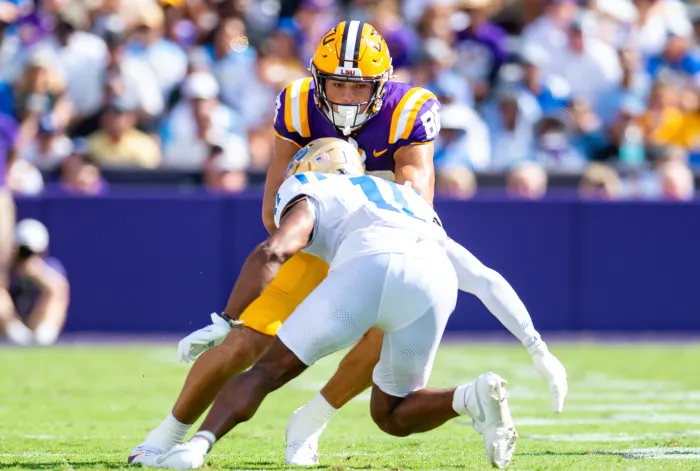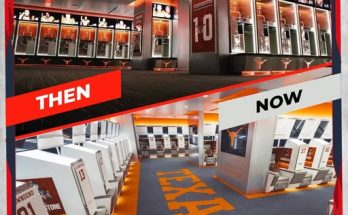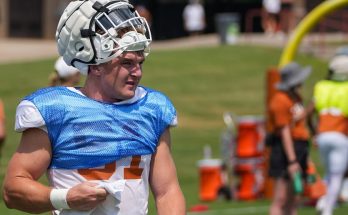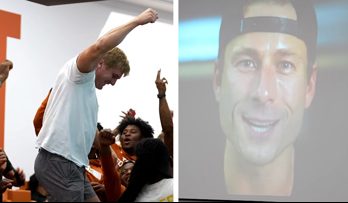Every year, the NFL Draft brings hope to franchises and fanbases alike, promising future stars who can transform the outlook of a team. But alongside every breakout story, there’s always a cautionary tale. And heading into the 2025 NFL season, one of the more sobering headlines involves a former LSU Tigers standout—once celebrated for his raw athleticism and dominance in the SEC—being named one of the most likely busts of this year’s NFL Draft class.
The player in question is edge rusher Maason Smith, a name that LSU faithful know well. Once hailed as a can’t-miss prospect, Smith entered Baton Rouge as a 5-star recruit and the crown jewel of Ed Orgeron’s final full recruiting class. Towering at 6-foot-6 and pushing 315 pounds, Smith had scouts drooling before he ever played a down. But despite his immense physical tools and occasional flashes of dominance, a mixture of injuries, inconsistency, and concerns about motor and technique have soured some NFL evaluators.
Smith was selected in the middle rounds of the 2025 NFL Draft by a team in desperate need of defensive line help. The selection initially drew mixed reviews, with some analysts praising the gamble on upside, while others called it a reach, questioning whether his development ever matched his recruiting pedigree. Now, just weeks after the draft, several major outlets have already pegged Smith as a prime candidate to flame out.
It’s a startling fall from grace for a player who, just a few years ago, looked like a future first-round lock. Smith’s trajectory at LSU started with plenty of promise. As a freshman in 2021, he recorded four sacks and 19 tackles in a rotational role, showcasing rare strength and quickness for his size. But his momentum was derailed in 2022 by a torn ACL suffered during the season opener against Florida State. That injury kept him sidelined for the remainder of the year, robbing him of crucial developmental reps and raising early durability concerns.
Returning to the field in 2023, Smith hoped to bounce back and assert himself as one of the SEC’s premier defensive linemen. Instead, his production plateaued. While he remained a physical presence and drew double-teams on occasion, he struggled with leverage, pad level, and conditioning. His stat lines didn’t jump off the page, and worse, there were whispers from within the program that his work ethic wasn’t quite matching his talent level.
By 2024, under a new defensive coaching staff, Smith’s role became increasingly diminished. Though he flashed in spurts—recording a memorable sack against Alabama and forcing a fumble against Ole Miss—his game was marred by inconsistency. He’d disappear for long stretches, often overwhelmed by technically sound offensive linemen. He finished the season with modest numbers: 3.5 sacks and 24 total tackles. Not terrible, but far from dominant.
Despite that, Smith decided to forgo another season in college and declared for the NFL Draft. The decision raised eyebrows, especially among those who believed another year at LSU could help him refine his game and rebuild his draft stock. But from Smith’s perspective, it was time. Injuries had already derailed one season, and he likely wanted to capitalize on his remaining upside before more mileage accrued.
At the NFL Combine, Smith tested well but not spectacularly. His measurables remained elite—wingspan, hand size, height, and weight all checked the boxes. But his 40-yard dash and agility drills were average, further cementing the narrative that he’s more of a projection than a polished product. Interviews reportedly yielded mixed impressions. While Smith spoke with confidence about his ability to dominate at the next level, teams were left wanting more specifics about his film study habits, positional versatility, and motor.
Scouting reports from respected analysts painted a similarly cautious picture. NFL Network’s lead draft analyst called him “a boom-or-bust prospect with tantalizing tools but a lack of refinement,” while ESPN’s Matt Miller noted that Smith “plays high, doesn’t consistently win off the snap, and needs to improve his hand usage to beat NFL-level linemen.”
Ultimately, one team saw enough to pull the trigger in the fourth round, gambling that a change in environment and NFL-level coaching could unlock the player who once dominated high school all-star games and terrorized freshman SEC quarterbacks.
However, the early signs in mini-camp have not been promising. Beat reporters covering Smith’s new team have described him as “raw,” “slow off the ball,” and “still struggling with pad level.” While it’s far too early to declare a verdict, the initial buzz—or lack thereof—has only fueled national conversations about potential busts. One anonymous scout went so far as to say, “He looks the part, but there’s a difference between looking like Tarzan and playing like him.”
The term “bust” carries a heavy connotation in NFL circles. It’s not just about performance—it’s about expectations. And in Smith’s case, the expectations were sky-high from day one. As a 5-star recruit from Louisiana, he was hailed as the next great LSU lineman, expected to follow in the footsteps of Glenn Dorsey, Michael Brockers, and Marcus Spears. But the leap from promising recruit to productive pro is steep, and many players—regardless of how highly they were rated at 18—never make it across.
There are those still rooting for Smith to succeed, especially within LSU circles. Former teammates have spoken publicly about his work ethic and desire to prove doubters wrong. “Maason’s got all the tools,” said one former Tigers defensive back. “He just needs to put it all together. He’s not lazy—he’s just still learning how to be great every snap.”
Indeed, some believe the “bust” label being floated around is premature and even unfair. After all, Smith missed nearly an entire season to injury and was part of a defense that, at times, lacked structure and identity. A more stable situation in the NFL—with a defensive line coach who understands how to develop big-bodied interior players—could help Smith make the leap.
But the NFL is an unforgiving league. Teams don’t have the luxury of waiting multiple years for a mid-round pick to blossom. And with Smith’s cap number relatively low, he’ll need to prove quickly that he belongs or risk being buried on the depth chart.
What’s particularly ironic is that Smith’s teammate at LSU, Mekhi Wingo, was drafted just a few picks earlier and has been generating the opposite buzz. Wingo, smaller but technically polished, has reportedly impressed with his motor, football IQ, and quick get-off. It’s a stark contrast that only sharpens the scrutiny around Smith.
This dichotomy between the two players reflects a broader philosophical debate within NFL front offices: do you bet on traits, or do you bet on tape? Smith is the poster child for traits—unmatched measurables, incredible length, rare size. Wingo represents the tape—relentless, disciplined, fundamentally sound. And in 2025, the early returns suggest that betting on traits might again prove to be a risky proposition.
To be clear, Smith’s story is not yet written. NFL history is filled with late bloomers and second-chance stars. If he can stay healthy, improve his conditioning, and embrace the grind of NFL development, he could absolutely carve out a long and productive career. But for now, he finds himself on an uncomfortable list—a list of players whose ceilings are high but whose floors are frighteningly low.
Being named as one of the most likely busts of the 2025 NFL Draft doesn’t seal Smith’s fate. But it does underscore the razor-thin margins at this level of football. Talent can open doors, but consistency, effort, and adaptability keep them open. Smith has the first part down. Whether he can deliver the rest will determine if this early criticism becomes prophecy—or just another motivational footnote in a remarkable comeback story.



